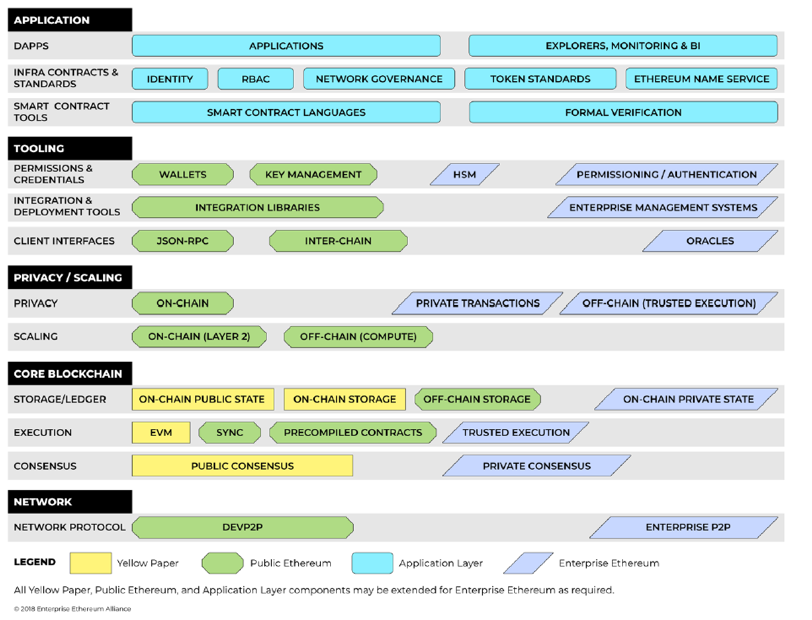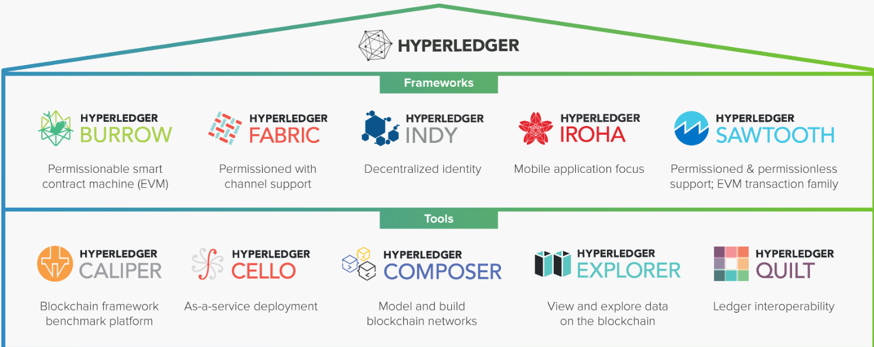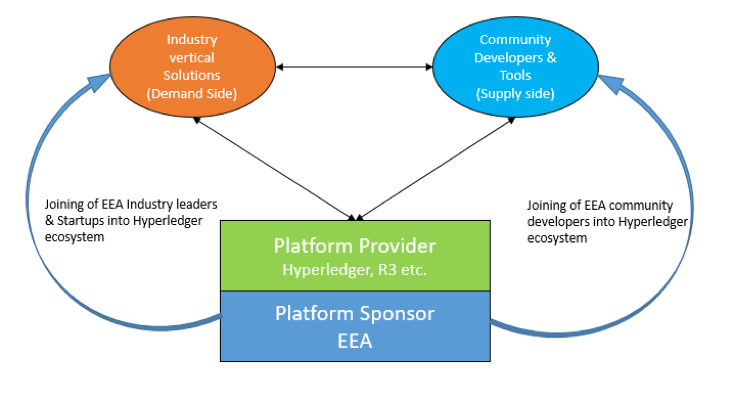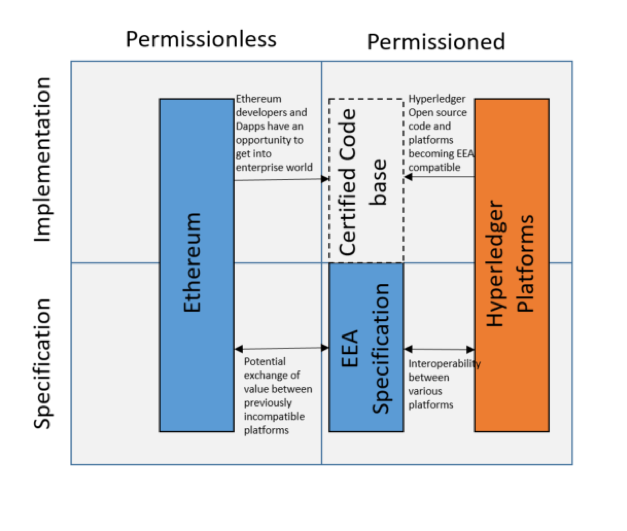This October, the two biggest enterprise blockchain platforms – Hyperledger and the Enterprise Ethereum Alliance (EEA) – reached agreement on a way to collaborate, bringing a potentially prolonged standards war to an early end. A long standards war may not serve any one’s interests, and with this agreement, we now have clarity on how blockchain solutions can be built and interoperate.
In this blog, we’ll analyze the evolution of Hyperledger and EEA, the forces that pushed the two to collaborate and avert a standards war, and possible ways in which enterprise blockchain might unfold in the future.
Evolution of Hyperledger and EEA
The first generation of blockchain was a simple immutable public ledger to record cryptocurrency transaction. Bitcoin is the best-known implementation. Next came the immutable public ledger with smart contracts, of which Ethereum is one of the best-known examples. Enterprise players like IBM realized the potential for blockchain in the enterprise world and launched permissioned blockchain with a focus on privacy, confidentiality, and auditability.
Here’s how the timeline played out: In December 2015, the Linux Foundation started an open source blockchain project. IBM contributed its Open Blockchain project to the Linux Foundation under the name Hyperledger Fabric. Hyperledger Fabric is a permissioned ledger that is both scalable and includes privacy features. Version 1.0 was released in July 2017. In early 2017, Ethereum started its own enterprise blockchain platform called Ethereum Enterprise Alliance.
Early Adopters
Enterprises looking for a manageable, permissioned distributed ledger jumped on the Hyperledger Fabric platform, including large projects at Maersk Line and Walmart. As more developers adopted the platform, a broader range of Hyperledger Fabric tools and reference implementation designs grew significantly. The only other enterprise blockchain platform in wide use, R3 Corda, was more limited in focus with uses cases primarily in banking and insurance.
While EEA was behind in the enterprise race, Ethereum was the hands-down winner in cryptocurrency with the majority of initial coin offerings (ICOs) using the Ethereum ERC-20 platform. With thousands of apps built and market capitalization crossing $100 billion for a brief time, EEA was a significant platform. However, the clock was ticking for success in the enterprise market. In May 2018, EEA issued a draft client specification hoping it would accelerate enterprise adoption. What was missing was ready-to-use blockchain platform code, the lack of which slowed adoption.
Enterprise Ethereum Architecture Stack v1 released in May 2018

Source: EEA White Paper
Blockchain Platform Feature Comparison
The ability to successfully wage a standards war for enterprise blockchain hinges on the availability of seven key factors. Let’s look at how Hyperledger Fabric and EEA platforms are positioned and analyze the impetus behind the recent joint collaboration.
- Installed base of users:Hyperledger has the lead regarding early adopters and large enterprise adoption of Hyperledger’s permissioned enterprise blockchain. In contrast, EEA has the largest ecosystem of public permission-less blockchain customers, applications, and tools. With the right backward-compatible architecture, the assets of this public blockchain can be channeled into a permissioned ledger as well. One of the goals of any platform is wide availability of tools and documentation. By creating dedicated, open source tools and thorough documentation, Hyperledger platform adoption accelerated relative to EEA.
Hyperledger platform with a wide range of Open source blockchain frameworks and tools

Source: Hyperledger
- Intellectual property rights: Hyperledger Fabric focused on pluggable consensus, private channels, role-based access control and open source code development. In contrast, EEA has focused on scalability, consensus mechanisms, zero-knowledge proof, distributed storage and standards development. The predominantly complimentary focus opens the door to collaboration without a conflict of interest.
- Ability to innovate: EEA has made the Ethereum specification backward compatible with previous iterations of the platform, allowing data to flow interoperable between generations of the platforms. Interoperability is an essential factor that’s driving Hyperledger to collaborate with EEA.
- First-mover advantage: Hyperledger has a first-mover advantage in the enterprise space for Permissioned Ledger, and tools like Composer are complemented by extensive documentation. EEA is behind on all the software development fronts, making collaboration even more attractive.
- Development capabilities: Hyperledger Fabric has a proven track record of open source code development tools. With Fabric 1.3, Hyperledger has added zero-knowledge proof, per-key endorsement policy and better querying mechanism. EEA has not been spending a comparable amount on open source development. The solution is either to borrow heavily from public Ethereum, which is not ideal considering the ideological difference or collaborate with existing players like Hyperledger.
- Strength in complements: The strength of Hyperledger is its ability to build open source code. The strength of EEA is that it has the backing of a working Public Blockchain platform, which can perform as an interoperability standard with a few changes in the enterprise world.
- Reputation and brand name: Both platforms are open and have highly trusted names backing them. Hyperledger and Ethereum are also highly respected names in the blockchain world. Many large enterprises are part of both consortiums.
The future of enterprise blockchain platforms
Given the foregoing, below are some scenarios for how the future may unfold for enterprise blockchain platforms.
Hyperledger frameworks adopt the EEA specification and gain community adoption: Hyperledger Burrow provides a modular blockchain client with a permission smart contract interpreter partially developed to the Ethereum Virtual Machine (EVM) specification. With forthcoming changes to the EEA Client specification and official collaboration with EEA, this smart contract interpreter could be upgraded to the latest EEA version and get certified. By adopting this potential new interpreter, Hyperledger Fabric could further solidify its position as the go-to enterprise blockchain platform because Ethereum community developers could quickly get on to the Hyperledger platform with the shortest learning curve.
The network effect may kick in with a new integrated platform

Source: by Author
Hyperledger stacks work in standard and interoperable modes: Hyperledger gains with the first mover advantage by filling the vacant slot in EEA’s permissioned ledger specification for open source code. The trade-off for agreeing to adopt the EEA specification is that Hyperledger frameworks will have to give up rights to build their own specification while building open source code and tools. Ethereum is not currently competing to develop open source code and tools, so this move could prompt EEA community developers to start developing open source code for Hyperledger, which would be a win for both Hyperledger and EEA. It would also open the door to cryptocurrency interoperability and value exchange between platforms, simplifying financial transactions between the platforms.
New positioning and benefit of each potential move

Source: by Author
More platforms like R3 Corda may adopt EEA specification: EEA-Hyperledger not being an exclusive deal, the standard-setting process can open up collaboration of R3 Corda and other platforms with EEA. This may drive common specifications across industry blockchain platforms, providing interoperability and accelerating enterprise adoption of Blockchain.
Conclusion
Whether any of these three predictions come true, or the market moves in an altogether different direction, remains to play out. The announcement of a collaboration between Hyperledger and EEA hints at where we might be heading, but the rapid evolution of interoperability standards means that surprises may yet lie ahead.
Related Blogs
Blockchain, IoT and Emerging Technologies
Can Blockchain Scale to Meet Enterprise Needs?
Blockchain: Do You Have an Identity Problem?
Beyond Hype: Tools for Developing Real-World Enterprise Blockchain Applications




